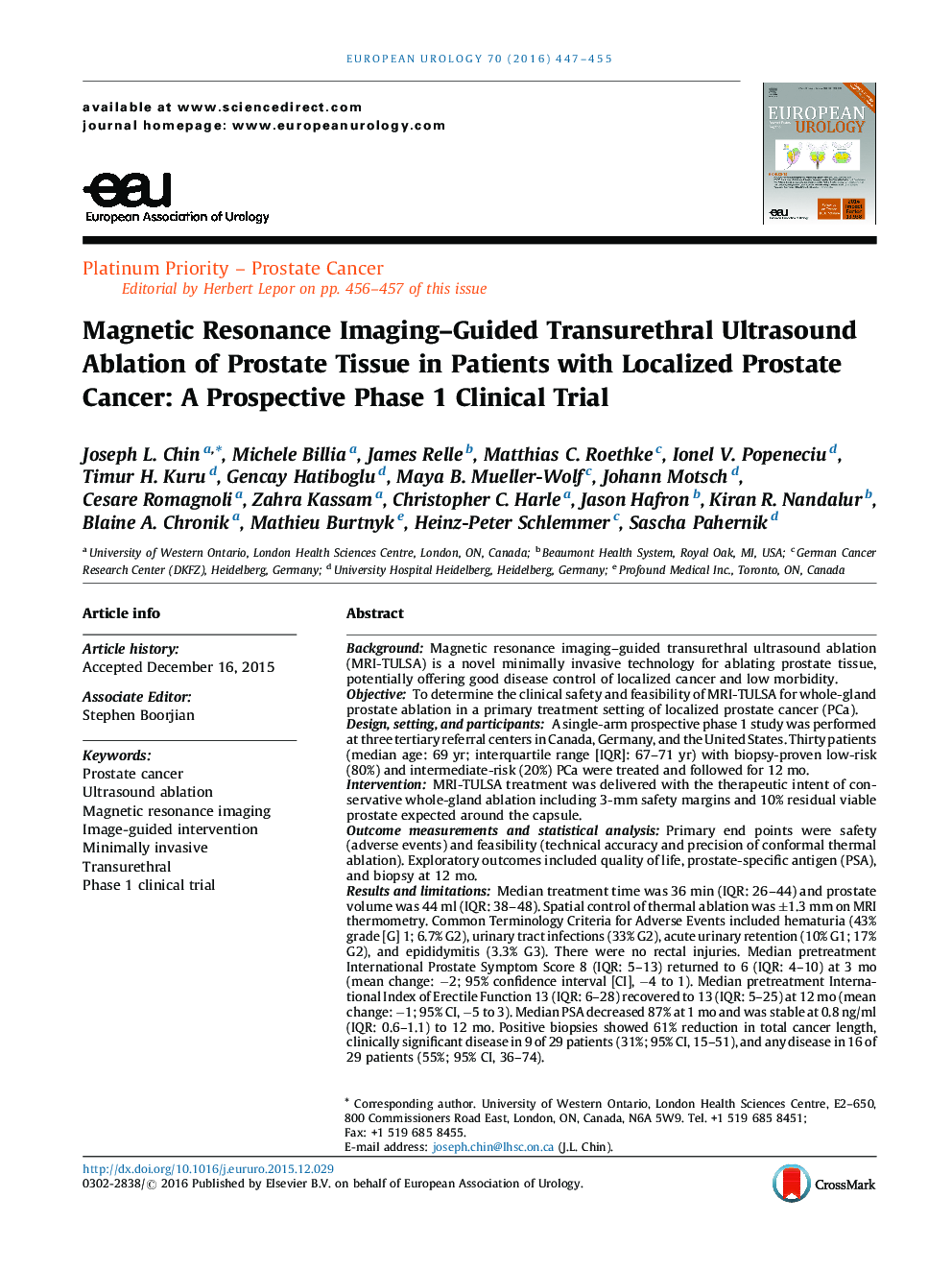| کد مقاله | کد نشریه | سال انتشار | مقاله انگلیسی | نسخه تمام متن |
|---|---|---|---|---|
| 6177125 | 1253090 | 2016 | 9 صفحه PDF | دانلود رایگان |

BackgroundMagnetic resonance imaging-guided transurethral ultrasound ablation (MRI-TULSA) is a novel minimally invasive technology for ablating prostate tissue, potentially offering good disease control of localized cancer and low morbidity.ObjectiveTo determine the clinical safety and feasibility of MRI-TULSA for whole-gland prostate ablation in a primary treatment setting of localized prostate cancer (PCa).Design, setting, and participantsA single-arm prospective phase 1 study was performed at three tertiary referral centers in Canada, Germany, and the United States. Thirty patients (median age: 69 yr; interquartile range [IQR]: 67-71 yr) with biopsy-proven low-risk (80%) and intermediate-risk (20%) PCa were treated and followed for 12 mo.InterventionMRI-TULSA treatment was delivered with the therapeutic intent of conservative whole-gland ablation including 3-mm safety margins and 10% residual viable prostate expected around the capsule.Outcome measurements and statistical analysisPrimary end points were safety (adverse events) and feasibility (technical accuracy and precision of conformal thermal ablation). Exploratory outcomes included quality of life, prostate-specific antigen (PSA), and biopsy at 12 mo.Results and limitationsMedian treatment time was 36 min (IQR: 26-44) and prostate volume was 44 ml (IQR: 38-48). Spatial control of thermal ablation was ±1.3 mm on MRI thermometry. Common Terminology Criteria for Adverse Events included hematuria (43% grade [G] 1; 6.7% G2), urinary tract infections (33% G2), acute urinary retention (10% G1; 17% G2), and epididymitis (3.3% G3). There were no rectal injuries. Median pretreatment International Prostate Symptom Score 8 (IQR: 5-13) returned to 6 (IQR: 4-10) at 3 mo (mean change: â2; 95% confidence interval [CI], â4 to 1). Median pretreatment International Index of Erectile Function 13 (IQR: 6-28) recovered to 13 (IQR: 5-25) at 12 mo (mean change: â1; 95% CI, â5 to 3). Median PSA decreased 87% at 1 mo and was stable at 0.8 ng/ml (IQR: 0.6-1.1) to 12 mo. Positive biopsies showed 61% reduction in total cancer length, clinically significant disease in 9 of 29 patients (31%; 95% CI, 15-51), and any disease in 16 of 29 patients (55%; 95% CI, 36-74).ConclusionsMRI-TULSA was feasible, safe, and technically precise for whole-gland prostate ablation in patients with localized PCa. Phase 1 data are sufficiently compelling to study MRI-TULSA further in a larger prospective trial with reduced safety margins.Patient summaryWe used magnetic resonance imaging-guided transurethral ultrasound to heat and ablate the prostate in men with prostate cancer. We showed that the treatment can be targeted within a narrow range (1 mm) and has a well-tolerated side effect profile. A larger study is under way.Trial registrationNCT01686958, DRKS00005311.
Journal: European Urology - Volume 70, Issue 3, September 2016, Pages 447-455